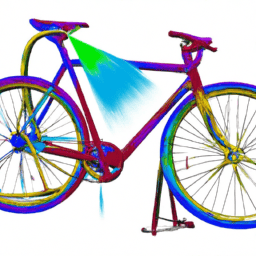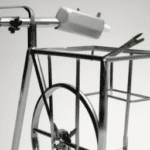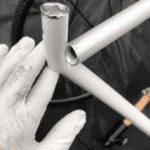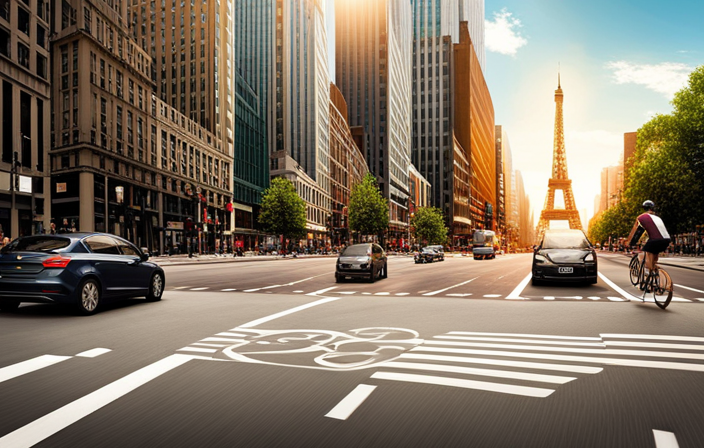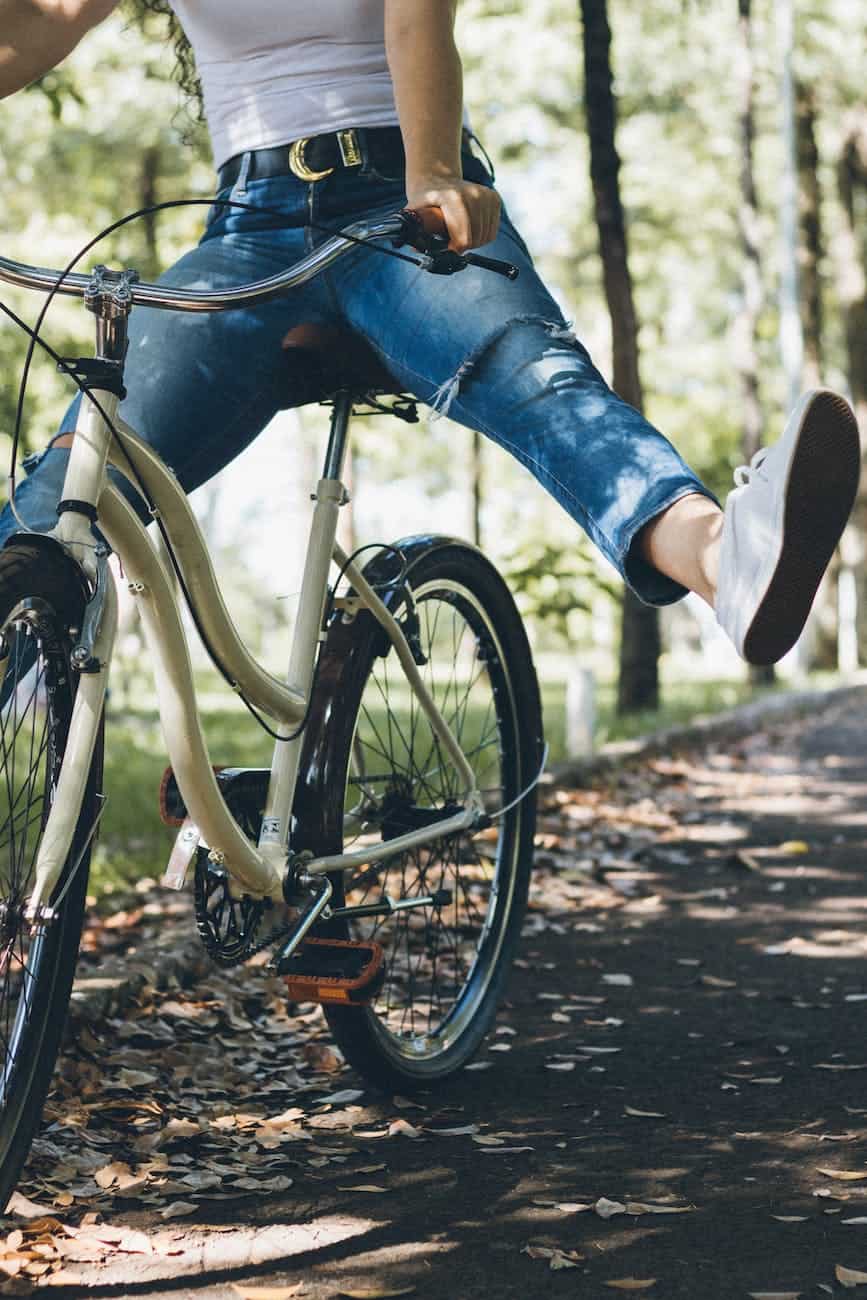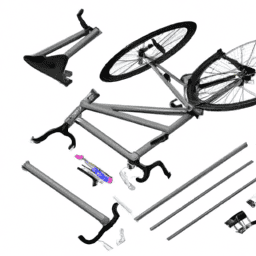Ever thought about refreshing the appearance of your bike? Perhaps it’s showing signs of wear, or you’re interested in personalizing it a bit more. Regardless of what drives you, tackling a bike frame paint job can be an enjoyable and satisfying endeavor.
In this article, we will guide you through the process of painting your bicycle frame step-by-step, so you can achieve the look you want. Let’s say you have an old, rusty bike that you want to give a new lease of life. You’ve been using it for years, and it’s been through all kinds of weather and terrain.
The paint is chipped, and the frame is starting to rust. You’ve decided it’s time to give it a fresh new look. Painting your bike frame is a great way to give your bike a new identity and make it look like new again. With the right tools and techniques, you can transform your old, rusty bike into a work of art.
So, let’s get started!
Key Takeaways
- Proper preparation is essential for a smooth paint job, including cleaning and sanding the frame and removing any rust spots before applying primer.
- Applying thin, even coats of paint with long, smooth strokes is crucial for minimizing brush marks and achieving a professional-looking finish.
- Consider color selection and finish options, such as matte or metallic, to complement the bike’s color scheme and achieve the desired look.
- Adding decals or hand-painted designs can personalize and customize the bike, but clear coat should be applied to protect the decals and ensure longevity.
Choose the Right Paint
You’ll want to make sure you’ve got the right paint for the job, so you don’t end up with a finish that chips or fades easily. When it comes to painting a bicycle frame, you have two options: using a spray can or a brush-on paint.
Spray paint is great for creating an even, smooth finish, but it can be difficult to control and can easily overspray. Brush-on paint, on the other hand, gives you more control over the application and is easier to touch up in case of any mistakes.
Another factor to consider is whether you want a matte or gloss finish. A matte finish has a more understated look and is less likely to show imperfections in the surface, whereas a gloss finish is more reflective and can make colors look more vibrant. Ultimately, the choice between matte and gloss comes down to personal preference and the style you’re going for.
With the right paint in hand, it’s time to prepare the surface to ensure the paint adheres properly.
Prepare the Surface
Now that you’ve chosen the right paint for your bicycle frame, it’s time to prepare the surface to ensure a smooth and even finish.
The first step is to clean the frame thoroughly, removing any dirt, grease, or grime that may be present.
Next, you’ll need to sand the surface to create a rough texture that will help the primer adhere better.
Finally, check for any rust spots and remove them using sandpaper or a wire brush before applying the primer.
By following these steps, you’ll ensure that your paint job is long-lasting and looks great.
Cleaning the Frame
First, grab a bucket of warm soapy water and a soft sponge to gently scrub away any dirt or grime from the surface of the frame. It’s important to ensure that the frame is thoroughly cleaned before painting to ensure that the paint adheres properly. There are several cleaning methods you can use, such as using a degreaser or rubbing alcohol, but warm soapy water is usually sufficient. Make sure to rinse the frame thoroughly with clean water and dry it off with a clean cloth or towel.
To give you a better idea of the necessary tools and materials, here is a helpful chart:
| Tool/Material | Description |
|---|---|
| Bucket | Used to hold warm soapy water |
| Soft Sponge | Used to gently scrub away dirt and grime |
| Degreaser | Optional cleaning agent to remove stubborn grease or oil |
| Rubbing Alcohol | Optional cleaning agent to remove any remaining residue |
| Clean Cloth/Towel | Used to dry the frame after cleaning |
After cleaning the frame, the next step is sanding and removing any rust.
Sanding and Removing Rust
To get your metal surface smooth and free of rust, start by using sandpaper like a sculptor using a chisel to carve out imperfections. Begin by selecting the appropriate sandpaper grits, which are typically labeled by their coarseness.
Start with a low-grit sandpaper, such as 60 or 80, to remove any large rust patches or scratches. Move on to a higher grit, such as 120 or 150, to smooth out the surface and remove any remaining rust. Finally, use a very fine-grit sandpaper, such as 220, to prepare the surface for the next step.
There are several rust removal techniques you can use when sanding your bicycle frame. If the rust is only surface-level, you can simply sand it away. However, if the rust has penetrated the metal, you may need to use a rust remover or converter to neutralize the rust before sanding.
Once the rust has been removed, wipe down the frame with a clean cloth to remove any dust or debris before moving on to the next step of applying primer.
Applying Primer
Once you have smoothed out the metal surface and removed any rust, it’s time to apply primer to ensure a smooth and even coat of paint will adhere to the surface. Primer acts as a bonding agent between the metal surface and the paint, preventing the paint from peeling or chipping off. There are different types of primer available on the market, including rust-inhibiting, self-etching, and high-build primers.
Rust-inhibiting primers are perfect for frames that have a small amount of rust. They contain rust inhibitors that prevent the rust from further spreading. Self-etching primers are ideal for frames that have a smooth surface and are not rusted. They etch the surface, creating a better surface for the paint to adhere to. High-build primers are used to fill in small dents and scratches, creating an even surface for the paint to adhere to. The benefits of using primer include better adhesion of the paint, a smoother finish, and enhanced durability. Applying primer is an essential step in painting a bicycle frame, ensuring the paint job lasts for years to come.
As you finish applying the primer, you can now move on to the next step of painting the frame.
Paint the Frame
Now that you’ve prepared the surface, it’s time to paint the frame.
The first step is to apply the first coat evenly, making sure to cover the entire surface. Once the first coat is dry, you can apply additional coats until you achieve the desired color and coverage.
To ensure a smooth finish, use long, even strokes and avoid over-spraying. Remember to follow the manufacturer’s instructions for drying time and recoat intervals.
Applying the First Coat
Applying the first coat is like spreading butter on toast. Smooth and even coverage is key to achieving a flawless finish. Before you begin, make sure you have all the necessary materials: a paintbrush, the paint color of your choice, and a well-ventilated area to work in.
Here are some painting techniques to keep in mind:
- Start with the top tube and work your way down. This way, you won’t accidentally smear wet paint on parts you’ve already painted.
- Apply the paint in thin, even coats. Don’t try to cover the entire frame in one go, or you’ll end up with drips and uneven patches.
- Use long, smooth strokes to minimize brush marks. Make sure to use enough pressure to spread the paint, but not so much that you create bubbles or streaks.
Once you’ve finished applying the first coat, let it dry completely before moving on to the next step of applying additional coats. With the right color selection and painting techniques, you’ll be well on your way to a beautifully painted bicycle frame.
Applying Additional Coats
To achieve that flawless finish you desire, you’ll want to make sure you’ve got a steady hand as you add more layers. As you apply additional coats, you’ll need to be mindful of the drying time between each layer. Here are some tips to help you choose the right colors and ensure that your paint job looks amazing.
Firstly, when choosing colors, it’s important to consider the color scheme of your bicycle and choose shades that complement each other. You can also get creative with different finishes such as matte or metallic. Secondly, you’ll need to allow enough time for each coat to dry completely before adding another layer. This can vary depending on the type of paint and the weather conditions, so be sure to check the label for recommended drying times. By following these tips, you’ll be on your way to a stunning paint job on your bicycle frame.
When you’re finished applying all of your coats, it’s time to move on to some tips for a smooth finish.
Tips for a Smooth Finish
If you want your ride to look like it was done by a pro, take your time and use a steady hand when adding more layers, like a chef carefully layering a cake with frosting. Here are some tips for achieving a smooth finish when painting your bicycle frame:
-
Use a polishing technique to remove any imperfections or rough spots on the surface of the frame before adding more layers of paint.
-
Choose a color that complements the style of your bike and fits your personal taste. Also, consider using a color that’s easy to maintain and doesn’t show dirt or scratches easily.
-
Apply each layer of paint in thin, even coats to prevent drips or unevenness. Allow each layer to dry completely before adding the next one.
-
Sand lightly between each coat of paint to create a smooth surface and ensure good adhesion of the next layer.
-
Finish with a clear coat to protect the paint and give it a glossy finish.
With these tips, you can achieve a professional-looking finish on your bicycle frame. Once you have completed the painting process, you can move on to adding custom details to make your bike truly unique.
Add Custom Details
For a unique touch, you can easily add custom details to your bicycle frame with stencils and spray paint. Stencil designs are a popular option, and you can find a variety of designs online or create your own.
Once you have your stencil, clean and prep your frame as you would for painting, then carefully position the stencil on the frame. Use masking tape or painter’s tape to secure the stencil in place, and make sure all edges are sealed to prevent any paint from bleeding through. Spray paint the stencil with thin coats, letting each coat dry before applying the next. Be sure to hold the can at a consistent distance and angle to prevent any drips or uneven coverage.
Once the paint has dried, carefully remove the stencil to reveal your custom design. Another option is to use vinyl decals, which can also be found online or custom made. Apply the decal to the frame following the manufacturer’s instructions, and use a credit card or squeegee to smooth out any bubbles or wrinkles.
Now that you have added your custom details, it’s time for the finishing touches. These include adding a clear coat to protect your paint job and give it a glossy finish, as well as any additional embellishments such as pinstriping or hand-painted designs. With a little creativity and patience, you can take your bicycle from basic to one-of-a-kind.
Finishing Touches
As you add the final touches to your two-wheeled masterpiece, your vision for a personalized and unique ride comes to life. One of the most important decisions to make during this stage is the color option for your bike frame.
Whether you choose a bold and bright color or a more subdued and classic hue, the finish should be smooth and consistent. Take your time to ensure an even application of paint, and allow ample time for drying between coats.
Another way to add a personal touch to your bike frame is by carefully considering decal placement. Decals are a great way to add subtle or bold graphics to your bike, and can be placed in various locations on the frame.
Consider placement near the head tube, seat tube, or top tube, and experiment with different sizes and styles. Just be sure to clean the surface thoroughly before applying, and use a clear coat to protect the decal and ensure longevity.
With these finishing touches, your custom painted bike frame will be a true reflection of your personal style and creativity.
Frequently Asked Questions
What is the best way to remove old paint from a bicycle frame?
To remove old paint from a bicycle frame, you have two options: chemical or mechanical. Chemical methods involve using solvents or acids, while mechanical methods involve sanding or media blasting. DIY painting allows for customization and cost savings, but professional painting ensures a high-quality finish.
Can I paint my bicycle frame without taking it apart?
Yes, you can touch up paint on your bicycle frame without taking it apart by using masking techniques to protect the areas you don’t want painted. It’s important to clean and sand the surface before applying the paint for best results.
How long should I wait between coats of paint when painting a bicycle frame?
To ensure optimal paint adhesion and a smooth finish, it’s essential to wait at least 24 hours between coats. Drying time tips vary based on the paint type and thickness, but generally, the thicker the paint, the longer it takes to dry. Follow paint thickness guidelines to avoid issues.
Can I use automotive paint on my bicycle frame?
You can use automotive paint on your bicycle frame, but there are pros and cons to both spray and brush application. Some of the best automotive paint brands for bicycle frames include Dupli-Color, Rust-Oleum, and VHT.
What type of paint should I use for a matte finish on my bicycle frame?
For a matte finish on your bicycle frame, consider using spray paint for a smoother application. A brush can leave streaks. Pros of using clear coat include protection and durability, but cons can be added weight and time for application.
Conclusion
Congratulations on successfully painting your bicycle frame! By following the steps outlined in this guide, you’ve not only given your bike a fresh new look, but also increased its durability and protection against rust and corrosion.
Did you know that people who regularly cycle have a 28% lower risk of death from any cause than those who don’t cycle, according to a study by the European Cyclists’ Federation? This highlights the importance of taking care of your bike and ensuring it’s in good condition.
By painting your frame, you’re not only improving its appearance, but also prolonging its lifespan and ensuring that you can continue to enjoy the many health benefits of cycling.
Remember to always choose the right paint, prepare the surface properly, and add any custom details before applying the final touches.
With a little bit of patience and attention to detail, you can achieve a professional-looking finish that will make your bike stand out from the crowd.
Happy painting!
